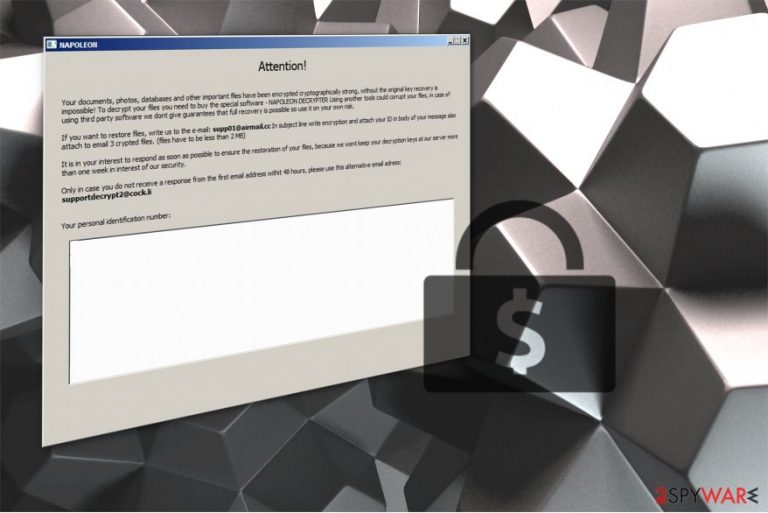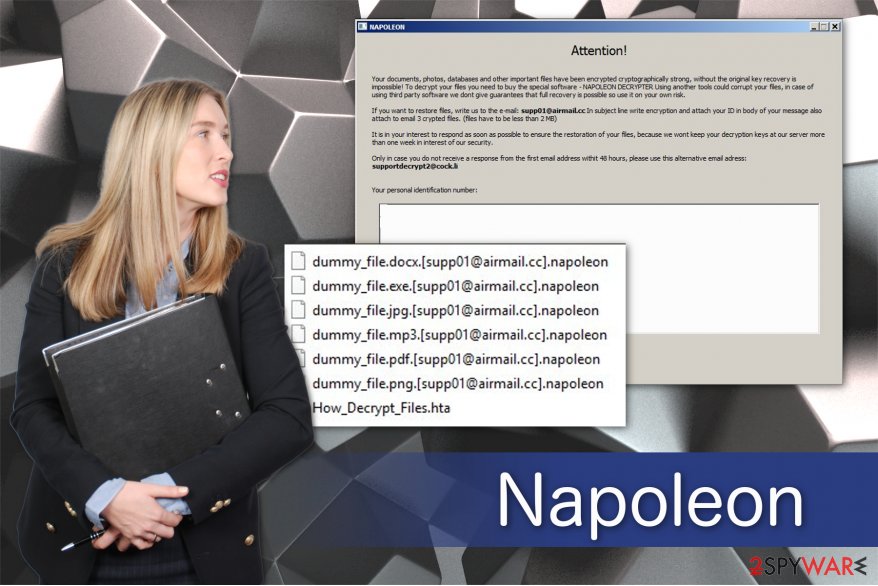Napoleon ransomware (Recovery Instructions Included) - Removal Guide
Napoleon virus Removal Guide
What is Napoleon ransomware?
Napoleon ransomware performs data encryption to obtain illegal profits

Napoleon is a file-encrypting virus which encodes data and makes it inaccessible to the user[1]. After encryption, it appends .[supp01@airmail.cc].napoleon extension at the end of the file-name and provides the data recovery instructions in How_Decrypt_Files.hta file.
The ransom note of Napoleon virus states the following:
If you want to restore files, write us to the e-mail: supp01@airmail.cc In subject line write encryption and attach your ID in body of your message also attach to email 3 crypted files. (files have to be less than 2 MB).
It is clear that the criminals want to look trustworthy. Likewise, they offer a free decryption of 3 files which are less than 2 MB. Additionally, they urge to contact them within a week, or they will delete Napoleon decrypter which is necessary in order to recover the corrupted data.
Besides, the developers of Napoleon indicate an alternative supportdecrypt2@cock.li email address in case they do not respond within 48 hours. At the moment, there is no reliable information about the amount of money which is demanded to purchase the decryption key.

However, we do not recommend contacting the criminals in either way. Note that not only you might not receive a decryptor after you make a transaction but also get malspam emails to infiltrate other high-risk computer infections[2]. Therefore, you should remove Napoleon ransomware and try alternative recovery methods. This way you will preserve your system from any further damage.
Likewise, pick FortectIntego and let it scan your computer thoroughly. After several minutes, the termination of crypto-malware will be finished, and you will be able to proceed to the decryption steps which are provided below. If you don't know how to start Napoleon removal, scroll down to find the elimination guide.
Distribution techniques
Cybercriminals employ several distribution methods to make sure that their malicious program reaches as many computers as possible. Currently, most of the ransomware spreads via fake software updates or spam emails. These techniques are highly advantageous since they are based on the delusional appearance — both emails and updates imitate legitimate companies, brands or their products.
Usually, malspam campaigns are created in a way to trick inexperienced computer user into opening the malicious attachment in the email. For example, it might look like a legitimate invoice from DHL, UPS or other well-known companies. As a result, the user opens the false document which starts an automatic download of the ransomware.
Moreover, fake software updates employ the same technique — they disguise under the appearance of widely used programs, such as Adobe Flash or VLC Media Player. Typically, you can encounter the fraudulent upgrades on highly suspicious websites appearing as a pop-up. The message might tell you that your access to particular media content is limited and you can fix it by downloading the software update.
At this point, we want to assure you that neither you should open emails from unknown senders nor install any updates offered elsewhere than in the official websites. These ransomware distribution techniques are based on the reckless behavior of gullible people. Therefore, you should carefully monitor your browsing activity and avoid any questionable content online.
Napoleon virus removal guide
It doesn't matter whether you have already been infected or not. Experts from NoVirus.uk[3] suggest you using a powerful security software all the time. It will not only help you to remove Napoleon from your system but protect from ransomware attack in the future as well. Note that this type of a virus is highly dangerous and trying to remove it by yourself might cause even more damage.
Therefore, you can complete Napoleon removal with a few simple steps:
- Download FortectIntego, SpyHunter 5Combo Cleaner or Malwarebytes;
- Let one of these antivirus programs to scan your files thoroughly;
- After it finishes ransomware elimination, proceed to the guide below and recover your files.
Getting rid of Napoleon virus. Follow these steps
Manual removal using Safe Mode
You should start Napoleon removal by rebooting your PC to Safe Mode:
Important! →
Manual removal guide might be too complicated for regular computer users. It requires advanced IT knowledge to be performed correctly (if vital system files are removed or damaged, it might result in full Windows compromise), and it also might take hours to complete. Therefore, we highly advise using the automatic method provided above instead.
Step 1. Access Safe Mode with Networking
Manual malware removal should be best performed in the Safe Mode environment.
Windows 7 / Vista / XP
- Click Start > Shutdown > Restart > OK.
- When your computer becomes active, start pressing F8 button (if that does not work, try F2, F12, Del, etc. – it all depends on your motherboard model) multiple times until you see the Advanced Boot Options window.
- Select Safe Mode with Networking from the list.

Windows 10 / Windows 8
- Right-click on Start button and select Settings.

- Scroll down to pick Update & Security.

- On the left side of the window, pick Recovery.
- Now scroll down to find Advanced Startup section.
- Click Restart now.

- Select Troubleshoot.

- Go to Advanced options.

- Select Startup Settings.

- Press Restart.
- Now press 5 or click 5) Enable Safe Mode with Networking.

Step 2. Shut down suspicious processes
Windows Task Manager is a useful tool that shows all the processes running in the background. If malware is running a process, you need to shut it down:
- Press Ctrl + Shift + Esc on your keyboard to open Windows Task Manager.
- Click on More details.

- Scroll down to Background processes section, and look for anything suspicious.
- Right-click and select Open file location.

- Go back to the process, right-click and pick End Task.

- Delete the contents of the malicious folder.
Step 3. Check program Startup
- Press Ctrl + Shift + Esc on your keyboard to open Windows Task Manager.
- Go to Startup tab.
- Right-click on the suspicious program and pick Disable.

Step 4. Delete virus files
Malware-related files can be found in various places within your computer. Here are instructions that could help you find them:
- Type in Disk Cleanup in Windows search and press Enter.

- Select the drive you want to clean (C: is your main drive by default and is likely to be the one that has malicious files in).
- Scroll through the Files to delete list and select the following:
Temporary Internet Files
Downloads
Recycle Bin
Temporary files - Pick Clean up system files.

- You can also look for other malicious files hidden in the following folders (type these entries in Windows Search and press Enter):
%AppData%
%LocalAppData%
%ProgramData%
%WinDir%
After you are finished, reboot the PC in normal mode.
Remove Napoleon using System Restore
In case you are still unable to install the security software, try the second method:
-
Step 1: Reboot your computer to Safe Mode with Command Prompt
Windows 7 / Vista / XP- Click Start → Shutdown → Restart → OK.
- When your computer becomes active, start pressing F8 multiple times until you see the Advanced Boot Options window.
-
Select Command Prompt from the list

Windows 10 / Windows 8- Press the Power button at the Windows login screen. Now press and hold Shift, which is on your keyboard, and click Restart..
- Now select Troubleshoot → Advanced options → Startup Settings and finally press Restart.
-
Once your computer becomes active, select Enable Safe Mode with Command Prompt in Startup Settings window.

-
Step 2: Restore your system files and settings
-
Once the Command Prompt window shows up, enter cd restore and click Enter.

-
Now type rstrui.exe and press Enter again..

-
When a new window shows up, click Next and select your restore point that is prior the infiltration of Napoleon. After doing that, click Next.


-
Now click Yes to start system restore.

-
Once the Command Prompt window shows up, enter cd restore and click Enter.
Bonus: Recover your data
Guide which is presented above is supposed to help you remove Napoleon from your computer. To recover your encrypted files, we recommend using a detailed guide prepared by 2-spyware.com security experts.If your files are encrypted by Napoleon, you can use several methods to restore them:
Use Data Recovery Pro
You can try to retrieve your data with the help of this tool.
- Download Data Recovery Pro;
- Follow the steps of Data Recovery Setup and install the program on your computer;
- Launch it and scan your computer for files encrypted by Napoleon ransomware;
- Restore them.
Windows Previous Versions feature might restore separate files
If you want to recover data with .napoleon extension, you should check whether the System Restore function was enabled. If it was, follow the instructions below:
- Find an encrypted file you need to restore and right-click on it;
- Select “Properties” and go to “Previous versions” tab;
- Here, check each of available copies of the file in “Folder versions”. You should select the version you want to recover and click “Restore”.
Try ShadowExplorer
This tool is extremely helpful if the ransomware hasn't deleted Shadow Volume Copies from your system.
- Download Shadow Explorer (http://shadowexplorer.com/);
- Follow a Shadow Explorer Setup Wizard and install this application on your computer;
- Launch the program and go through the drop down menu on the top left corner to select the disk of your encrypted data. Check what folders are there;
- Right-click on the folder you want to restore and select “Export”. You can also select where you want it to be stored.
Currently, there is no official Napoleon Decryptor
Finally, you should always think about the protection of crypto-ransomwares. In order to protect your computer from Napoleon and other ransomwares, use a reputable anti-spyware, such as FortectIntego, SpyHunter 5Combo Cleaner or Malwarebytes
How to prevent from getting ransomware
Stream videos without limitations, no matter where you are
There are multiple parties that could find out almost anything about you by checking your online activity. While this is highly unlikely, advertisers and tech companies are constantly tracking you online. The first step to privacy should be a secure browser that focuses on tracker reduction to a minimum.
Even if you employ a secure browser, you will not be able to access websites that are restricted due to local government laws or other reasons. In other words, you may not be able to stream Disney+ or US-based Netflix in some countries. To bypass these restrictions, you can employ a powerful Private Internet Access VPN, which provides dedicated servers for torrenting and streaming, not slowing you down in the process.
Data backups are important – recover your lost files
Ransomware is one of the biggest threats to personal data. Once it is executed on a machine, it launches a sophisticated encryption algorithm that locks all your files, although it does not destroy them. The most common misconception is that anti-malware software can return files to their previous states. This is not true, however, and data remains locked after the malicious payload is deleted.
While regular data backups are the only secure method to recover your files after a ransomware attack, tools such as Data Recovery Pro can also be effective and restore at least some of your lost data.
- ^ Sherisse Pham. What is ransomware?. CNN. Breaking News, U.S., World, Weather, Entertainment & Video.
- ^ Jatheon. The Dangers of Spam. Jatheon. Email Archiving and eDiscovery Compliance Solutions.
- ^ NoVirus. NoVirus. Security and Spyware News.







